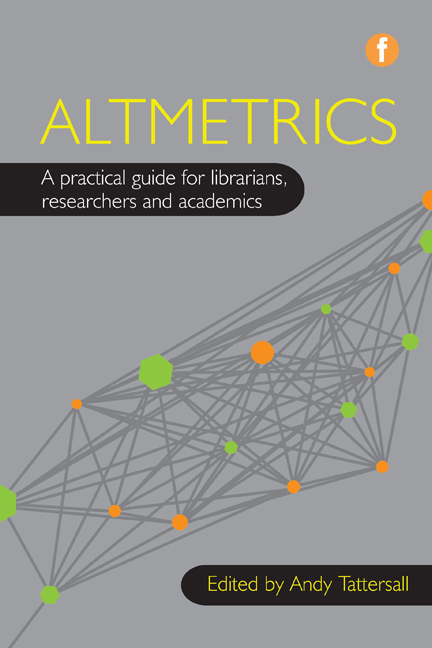Book contents
- Frontmatter
- Contents
- Contributors
- 1 Introduction
- 2 Road map: from Web 2.0 to altmetrics
- 3 ‘Metrics of the trade’: where have we come from?
- 4 The evolution of library metrics
- 5 The rise of altmetrics
- 6 Beyond bibliometrics: altmetrics reflects information about engagement with more types of scholarly content from more types of consumers
- 7 Considerations for implementing new technologies
- 8 Resources and tools
- 9 The connected academic: implementing altmetrics within your organization
- 10 Appmetrics: improving impact on the go
- 11 Open peer review
- 12 Conclusion
- Index
1 - Introduction
Published online by Cambridge University Press: 08 June 2018
- Frontmatter
- Contents
- Contributors
- 1 Introduction
- 2 Road map: from Web 2.0 to altmetrics
- 3 ‘Metrics of the trade’: where have we come from?
- 4 The evolution of library metrics
- 5 The rise of altmetrics
- 6 Beyond bibliometrics: altmetrics reflects information about engagement with more types of scholarly content from more types of consumers
- 7 Considerations for implementing new technologies
- 8 Resources and tools
- 9 The connected academic: implementing altmetrics within your organization
- 10 Appmetrics: improving impact on the go
- 11 Open peer review
- 12 Conclusion
- Index
Summary
Introduction
The purpose of this chapter is to give an introduction and context to the book and its theme. It will give an overview of the changes occurring in academia right now that are part of a wider picture that includes open access, MOOCs (Massive Open Online Courses), big data, emerging learning technologies and, finally, altmetrics. It will explain why this change is happening, how it is all connected, and how some library and information professionals are at the heart of it, while others should pay heed to it. It will provide an overview of the key ideas and themes within altmetrics as well as how this fits in with existing academic cultures.
Altmetrics focuses on research artefact level metrics that are not exclusive to traditional journal papers but also extend to book chapters, posters and data sets among other items. It offers an alternative indicator of attention, review and conversation that adds a highly responsive layer to the slower to accrue traditional research metrics.
Altmetrics is one of those terms, like MOOCs and big data, that many people in academia have heard of but are not entirely sure what it means. For a start, it sounds rather geeky, and perhaps something that sits within the domain of a group of experts, for example statisticians. In reality it is much simpler than that and has a potentially much wider audience, some of whom are already unknowingly using some of the technologies that contribute to altmetrics. Altmetrics has the potential to be of use to every academic, PhD and master's student thinking of going into a research career. While the term and the concept of altmetrics have been around in popular use only since 2012, the ideas and opportunities that seek to exploit it have been around for longer.
Although altmetrics is not commonplace or widely discussed outside the offices of some fund holders, publishers, PhD students, scientists and a few librarians, it has significant traction and potential. So much so that this book was commissioned to help library and information professionals gain a better understanding of the subject. To this author's mind, librarians and information professionals have an important part to play in the use of altmetrics, and the opportunity is there for them to take, should they wish to do so.
- Type
- Chapter
- Information
- AltmetricsA practical guide for librarians, researchers and academics, pp. 1 - 10Publisher: FacetPrint publication year: 2016

